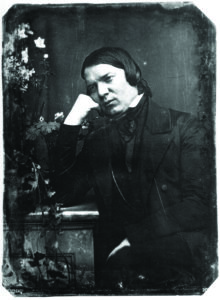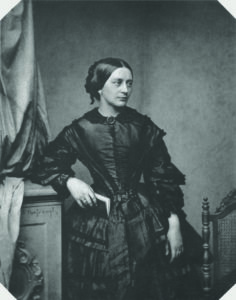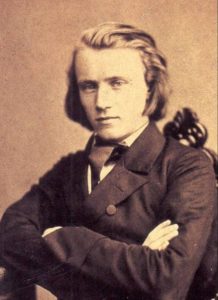
On February 27, 1854, Robert Schumann attempted suicide by jumping from a bridge into the river Rhine. Some fishermen soon rescued him, but his sanity was gone. For years he had struggled with mental illness: he heard voices; the note “A” droned on in his head for hours; strange music played in his head; visions of angels turned into hellish nightmares. When he emerged from the river, he was taken by his own request to an asylum, where he would spend the remaining two years of his life. Despite lucid periods, the great composer would never recover.
As soon as news of the catastrophe reached him, Johannes Brahms raced to Düsseldorf to assist Robert’s wife Clara, who was pregnant with their seventh child. Johannes had arrived at the Schumann’s home five months before as a young, unknown, aspiring composer. After hearing Johannes play some of his own music, Robert and Clara had instantly recognized him as a genius. They welcomed him into their household, and Robert declared Brahms the true heir of Beethoven in a widely read musical publication, making him famous overnight.
For Johannes, the Schumanns were generous mentors and friends, and he was eager to help them in their time of need. He took up lodgings in Düsseldorf and began to help Clara sort through Robert’s affairs and look after her children as she prepared for childbirth and the resumption of her career as one of Europe’s leading pianists.

As Johannes and Clara spent more time together, their feelings for each other deepened into something beyond friendship. Brahms wrote to a friend, “I believe that I do not have more concern for and admiration for her than I love her and find love in her. I often have to restrain myself forcibly from just quietly putting my arms around her and even—: I don’t know, it seems to me so natural that she could not misunderstand.” Clara confided to her diary, “There is the most complete accord between us…It is not his youth that attracts me: not, perhaps, my flattered vanity. No, it is the fresh mind, the gloriously gifted nature, the noble heart, that I love in him.” Such feelings were unspeakable and treacherous so long as Robert remained alive. After Robert’s death, Clara and Johannes went to Switzerland accompanied by family. No one will ever know all that passed between them, but after the sojourn in Switzerland, the two parted ways. Brahms never married and Clara would never remarry; they would remain steadfast friends for the rest of their lives.
Within days of Schumann’s breakdown, Brahms had begun composing. At first, he wrote the music he heard as a sonata for two pianos, but soon realized “even two pianos aren’t enough for me,” and began to rework it as a grand symphony that would fulfill Schumann’s prophecies. The challenge was daunting; the entire musical world was waiting to judge his new creations, and Brahms was dissatisfied with his work. Almost exactly one year later, the solution became clear to him. He wrote to Clara, “Imagine what I dreamed of last night. I used my hapless symphony to make a concerto, and was playing it as such…” Even with the work’s final form decided, it would be another X years before Brahms felt it was ready for public performance.
The concerto begins with what at least two of Brahms’ friends confirmed was his immediate musical response to Schumann’s suicide attempt:
A cataclysmic low D thunders from the depths of the orchestra, and the strings enter with a jagged idea in the wrong key—B flat major. This conflict between D and B flat immediately creates a powerful tension that will unfold throughout the movement. As the storm of the opening progresses, the music turns inevitably to D minor, leading to a soft, melancholy melody above a gently rocking accompaniment that flows like the waters of a river. This leads to a shivering new theme in B flat minor, which dies away only to make way for a renewed attack by the opening idea. When this violent episode dissipates, the soloist enters with a quiet, hypnotic new melody. The soloist then takes up the tumultuous melodic material of the orchestral introduction, but this time it leads to a new theme in F major. This warm, expressive hymn is played first by the soloist alone, then the strings as the soloist soars above. The soloist then engages in a duet with a solo horn, which evokes wide open, pastoral mountainsides. As this episode fades away, the tranquil mood is shattered by the return of the opening themes, which serve as the basis for extensive development. When the opening returns, Brahms changes the harmonies—instead of B flat major, we hear an even more unstable E major 7 chord (in third inversion!). Though surprising, this strange harmony leads back to D minor with an inevitable logic that banishes B flat major, making it clear that the tragic key of D minor will prevail. Some hope is offered when the hymn-like theme returns in full, this time in D major, but ultimately D minor returns in the coda.

As Brahms was composing the slow second movement in 1857, he wrote to Clara that he was “painting a tender portrait of you, which is to be the Adagio.” Upon hearing it, Clara remarked that “the whole piece has something churchly about it; it could be an Eleison.” Indeed, the opening shows the influence of the renaissance choral music the young Brahms was assiduously studying at the time. Unbeknownst to Clara, beneath the first five bars of the D major string melody Brahms had written “Benedictus, qui venit, in nomine Domini!” (“Blessed is he who comes in the name of the Lord”) as if the words were meant to be sung to the music. In 1854, Brahms had written to Clara that “I think of you as going to the concert hall like a high priestess to the altar”; surely this music is an expression of the same sentiment.
After the consoling “Benedictus” melody, the soloist enters, transforming the renaissance-style counterpoint into a more personal, subjective meditation. The orchestra and soloist alternate, as if the orchestra is a choir singing while the soloist is an individual lost in thought. A delicate filigree passage in the piano leads to a new, more Romantic, minor-key melody that grows to a searching dialogue between the soloist and orchestra. The “Benedictus” melody then returns in the cellos, leading to a more hopeful, expansive theme in the woodwinds accompanied by arpeggios in the piano. After a brief written out cadenza in the piano, the movement ends with the “Benedictus” melody.
Having written these two profoundly moving movements, Brahms was at a loss when faced with the challenge of bringing the concerto to a satisfying conclusion. Ever the student of music history, he turned to Beethoven for help, modelling his finale on the last movement of Beethoven’s Piano Concerto No. 3 in C minor. His finale followed the structure of Beethoven’s, but would be filled with his own original ideas. The soloist begins with a furious, Bach-inspired melody, to which the orchestra immediately responds. This main theme alternates with contrasting episodes by turns defiant and lyrical, leading to a coda in which the main theme returns in a hopeful D major.
When Brahms completed his concerto in 1858, he performed as piano soloist at the world premiere in Hanover the following year. The concerto was greeted with a cool reception, but it was nothing compared to the audience reaction after the first performance in Leipzig. Brahms wrote to a friend, “My Concerto has had a brilliant and decisive—failure…At the conclusion three pairs of hands were brought together very slowly, whereupon a perfectly distinct hissing from all sides forbade any such demonstration…I believe this is the best thing that can happen to one; it forces one to concentrate one’s thoughts and increase one’s courage. After all I am only experimenting and feeling my way as yet. But the hissing was too much of a good thing, wasn’t it?”
Brahms had written one of the longest and most emotionally intense concertos since Beethoven; contemporary audiences had come to expect something shorter, lighter and flashier. The concerto would only begin to be accepted years later, thanks in no small part to Clara’s performances of it. It is one of Brahms’ most personal and powerful works, and is a cornerstone of the repertoire today. —Calvin Dotsey
See the Houston Symphony perform Brahms’ Piano Concerto No. 1 live with pianist Kirill Gerstein and Music Director Andrés Orozco-Estrada January 11, 12 & 13, 2018. Get tickets and more information at houstonsymphony.org.



